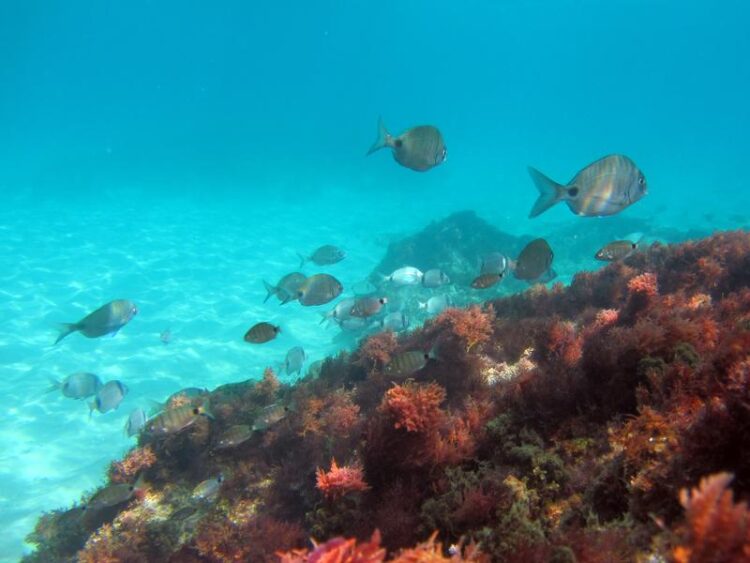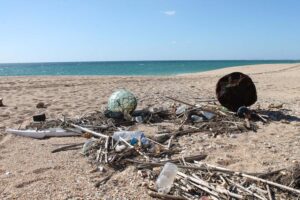Doubtful indulgence: How young fish ingest plastic

Sea bream of different species often swim together over seagrass beds or algae-covered rocks on the Algarve coast.
(c) Carolin Müller / Leibniz Centre for Tropical Marine Research
In a new study, marine biologist Carolin Müller of the Leibniz Centre for Tropical Marine Research (ZMT) demonstrates the ingestion of microplastic particles by juvenile sea bream. She also investigated which environmental factors determine whether the young stages of the fish ingest the plastic.
Nearshore ecosystems, such as lagoons and river estuaries, are important nurseries for a variety of commercially important fish species. In the seagrass beds of the lagoons, the fish find shelter and food and thus ideal conditions for growing up. At the same time, however, a large proportion of plastic pollution enters the sea via rivers and coasts – in the process, seagrass meadows or algae forests can act like nets in which the plastic particles get caught.

Credit: Carolin Müller / Leibniz Centre for Tropical Marine Research
In a study on sea bream, marine biologist Carolin Müller from the ZMT, together with colleagues from the Centro de Ciências do Mar in Portugal, investigated which environmental factors determine whether the young stages of the fish ingest the plastic: “In particular, the larvae and young fish, which represent the bottleneck in the development of fish populations, are very sensitive to environmental stress. Also, juvenile sea bream are omnivorous, so they may be particularly vulnerable to plastic ingestion,” she explains. Too little is still known about how plastic affects fish and their sensitive young, she adds.
Carolin Müller and her team investigated the white sea bream for their study. This is one of several sea bream species that have their nursery in the Ria Formosa, a lagoon in the Algarve in southern Portugal. Sea bream are found in both tropical and temperate waters of the Atlantic, Indian and Pacific Oceans. The popular food fish are also widespread in the Mediterranean Sea.
Over several months, the researchers took samples from five sites that had been exposed to varying degrees of human influence. There, they caught juvenile sea bream and then examined the size, weight and stomach contents of the fish to gain information about their food preferences. They also collected a variety of data, including information on the sea bream’s prey organisms and on microplastic pollution in the water and on the seafloor.
As it turned out, the young fish used a broad food spectrum. Some ate mainly small crustaceans such as copepods, others mainly insects from the water surface. Still others preferred to eat worms and other invertebrates from the seafloor or a vegetarian diet of algae and seagrass.
But plastic particles were also found in the stomachs of the fish, especially those that had mainly ingested plant food. “In principle, young sea bream are quite capable of distinguishing what is edible from what is not. They can crack shells with their teeth and spit out the shell fragments. This special ability also enables them to distinguish larger, harder plastic fragments from natural prey and spit them out again,” explains Carolin Müller. “The plastic fibers in the stomachs of some fish were often interwoven in tangles with seaweed and other plant materials. We assume that this plastic was eaten unnoticed.” Fish that lived closer to urban areas, such as cities or beach resorts, had also ingested more plastic, as plastic pollution was higher in those areas.
If fish eat larger amounts of plastic and their food intake is affected, this can result in adverse health effects and even death. Important insights into their feeding biology are therefore needed to understand what factors play a role in ingestion, and which life stages and populations are particularly vulnerable to plastic pollution. Ultimately, the degradation of juvenile fish through an interplay of pollution, climate change and habitat destruction can have a significant impact on coastal fish populations, threatening the livelihoods of millions of people.
Carolin Müller plans further studies on the topic: “We want to focus on commercially important species such as anchovies and sardines, which differ significantly from sea bream in their feeding habits as filter feeders. The less picky nature of their dietary intake may make these fish more susceptible to plastic pollution. At the same time, we are also investigating the ingestion of microplastics by fish species that migrate between surface waters and the deep sea and may be a transport vehicle for plastic particles.”
Video
https://youtu.be/iqttJO_HgfE
The specialized nature of feeding enables sea bream to distinguish what is edible from what is not. This ability is already evident in juvenile fish: in the feeding experiment, many juvenile sea bream immediately spit out plastic again.
Copyright: Carolin Müller, Leibniz Centre for Tropical Marine Research
If you are interested in showing the video on a media platform, we can provide you with the file. Please mention the copyright.
Wissenschaftliche Ansprechpartner:
Dr. Carolin Müller
Leibniz Centre for Tropical Marine Research (ZMT)
Email: carolin.mueller@leibniz-zmt.de
Originalpublikation:
Müller, C., Erzini, K., Dudeck, T. et al. Variability of prey preferences and uptake of anthropogenic particles by juvenile white seabream in a coastal lagoon nursery ground. Environ Biol Fish (2023). https://doi.org/10.1007/s10641-023-01423-z
Media Contact
All latest news from the category: Ecology, The Environment and Conservation
This complex theme deals primarily with interactions between organisms and the environmental factors that impact them, but to a greater extent between individual inanimate environmental factors.
innovations-report offers informative reports and articles on topics such as climate protection, landscape conservation, ecological systems, wildlife and nature parks and ecosystem efficiency and balance.
Newest articles

Red light therapy for repairing spinal cord injury passes milestone
Patients with spinal cord injury (SCI) could benefit from a future treatment to repair nerve connections using red and near-infrared light. The method, invented by scientists at the University of…

Insect research is revolutionized by technology
New technologies can revolutionise insect research and environmental monitoring. By using DNA, images, sounds and flight patterns analysed by AI, it’s possible to gain new insights into the world of…

X-ray satellite XMM-newton sees ‘space clover’ in a new light
Astronomers have discovered enormous circular radio features of unknown origin around some galaxies. Now, new observations of one dubbed the Cloverleaf suggest it was created by clashing groups of galaxies….





















